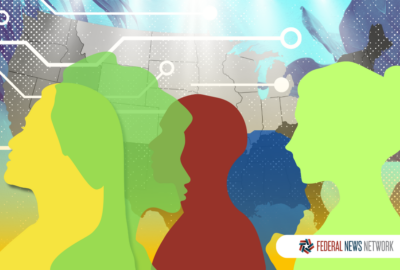Insight by Iron Bow and Intel
AI PCs for federal: The future of edge computing
How AI PCs supplemented by extreme search capabilities will enable federal employees at the edge to leverage more data to make better decisions, faster.
Artificial Intelligence PCs are here, and federal agencies need to start thinking about how they’re going to use them. Much like smartphones led to the advent of apps that changed the way we shop, travel and do business, AI PC capabilities will have the same disruptive effect that will change both engineering and innovation.
“We’re writing the future right now. We’re talking to hundreds of independent software vendors all over the country to say, ‘What’s in the realm of possible now that we’ve given you the capability to run AI at the edge? What problems do you want to solve? We have seen a litany of amazing solutions,” said Jason Dunn-Potter, senior strategist at Intel. “I’m really excited about moving data to the edge where people are doing the work. As an innovator, nothing is more frustrating than having all the tools and the resources to solve the governments problems, but they didn’t know we already solved their problem.”
Decision-making at the edge
AI PCs provide decision-makers at the edge — from battlefields to farm fields — with the ability to analyze data at unprecedented speeds, delivering real-time insights that can mean the difference between life and death. That capability is supported by the Lewis Roads Labs (LRL) extreme search tool, which can rapidly find anomalies in massive data sets, and provide that data to AI PCs for action. For example, Extreme Search can parse millions of interactions with federal websites each day in order to find the soft touch probing for vulnerabilities.
AI PCs can also analyze live drone footage in disaster response scenarios. By comparing real-time video to pre-existing maps, they can quickly identify damaged infrastructure, such as a collapsed bridge, more rapidly than human responders. At the same time, they can detect heat signatures that may indicate hazards, like downed power lines, which might not be visible to human eyes.
In a combat zone, AI PCs can help to lift the fog of war by processing intelligence, surveillance, and reconnaissance data in real-time right in the field. Enhanced with computer vision and other new sensor technology users can quickly leverage detailed analytics, AI PCs can pick up details the human senses can’t in order to identify friend or foe and make better snap decisions by shortening the OODA loop to the edge commander or leader.
“Information drives the speed and effectiveness in which we make decisions. I have to observe and orientate. The longer it takes me to decide what I’m dealing with, the longer the decision cycle,” said Dunn-Potter. “Timely information gives leaders the best chance of a positive outcome. However, great leaders tell me an 80% solution right now is better than 100% solution too late. In future digital engagements why not have both?
To facilitate that, the LRL Extreme Search can augment electronic warfare by helping to sort the signal from the noise — literally. Combat zones have many electronics sending a great deal of signals across numerous frequencies of the spectrum. An electronic warfare team needs to analyze all those signals, and separate out the allied radios, drones, satellites and radars. In a dynamic coalition operation, especially in urban environments, the electronic spectrum will be chaotic. We have dozens of known friendly & enemy wave forms and will have a challenge sorting good v. bad and especially the unknown frequencies. The LRL Extreme Search can swiftly find the unknowns and then aid in the identification, triangulation and risk level of the signal.
Natural language processing
Language is another major source of unstructured data; AI PCs can help surmount language barriers to provide more information to warfighters and first responders in the field. For example, in a combat scenario, it’s unlikely captured intelligence documents will be in the warfighter’s native language. Beyond even that, it will contain idioms, slang or dialects particular the local community which may differ from the literal meaning. Natural Language Processing (NLP) running on AI PCs can parse that information and help make up for a limited number of linguists. It will also aid in isolating which group or community someone is part of. Linguists will become maximized by bringing their culture knowledge to the forefront via the ability to get them the most important data to assess swiftly.
First responders need to be able to communicate with anyone at the scene in order to assess the situation accurately. According to Dunn-Potter, AI PCs equipped with NLP could serve as digital translators, automatically identifying languages and determining the best communication approach. For instance, NLP technology can assist Border Patrol agents by helping differentiate refugees from potential smugglers. If a group of 20 people intercepted at the same crossing all speak a specific Spanish dialect, they are likely from the same region. However, if two individuals from that group speak a different dialect, it could be an indicator worth investigating. While this is not definitive proof of human trafficking, it offers a lead to explore.
The realm of possibility
These examples are just a few of the many ways AI PCs, combined with LRL Extreme Search, can empower agencies to address challenges at the edge. The next question is: If you could solve anything what would you want to fix first and have you considered how this new innovation revolution could be leveraged?
“We’re very excited to talk about the impact to cities, counties, states, the Defense Department and other federal agencies about how we can enhance what they’re doing with the tools we have built,” Dunn-Potter said. “We have to give the demand signal to the over 500 hundred partner software vendors: These are the problems that the government wants to solve first. Now what’s in the realm of possibility as we’re exploring all of that? I’m optimistic about creating a safer, better world as we explore these tools.”
Copyright © 2024 Federal News Network. All rights reserved. This website is not intended for users located within the European Economic Area.





